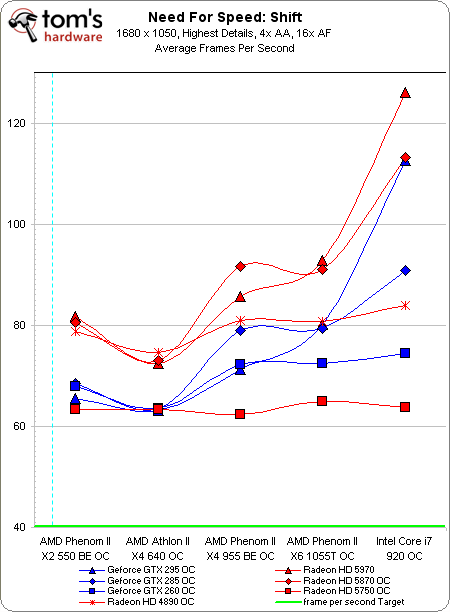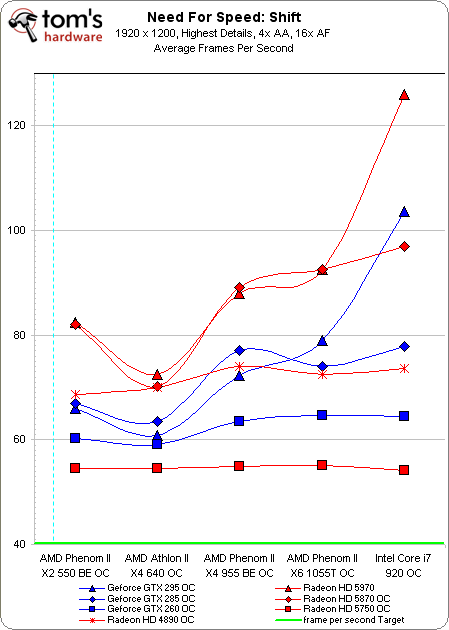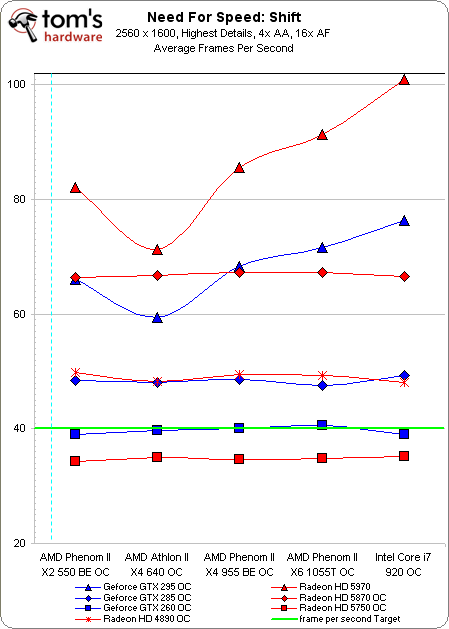Part 4: Building A Balanced Gaming PC
What does it mean to build a truly-balanced PC? How great would it be to piece together a machine bottlenecked by neither CPU or GPU? We set forth to measure the perfect balance in seven different games and four resolutions in this fourth of many parts.
Benchmark Results: Need For Speed Shift
Need For Speed: Shift
The stock platforms in Parts 1 and 2 pretty much breezed through Fallout 3 and Race Driver GRID, so we looked into replacing those two games with potentially more demanding titles. We are still looking into a new RPG, but for Parts 3 and 4, we're using Need for Speed: Shift as our racing title of choice.
In order to benchmark Shift, we use FRAPS to measure a 60 second lap around the Dakota GP track. We utilize the demanding cockpit view and start in the back of the pack, which should provide close to a worst-case scenario for performance. As with GRID, I notice when frame rates dip below 40 FPS, but we’ll shoot for an average of 40 FPS as our target.
Also, care was again taken to maintain race-to-race consistency, and an average of three races were recorded to further improve fairness and accuracy. We dropped 1280x1024 for this title, as the game does not have built-in full-screen support for 4:3 or 5:4 aspect ratios while running a 16:10 native desktop resolution.
The Radeon HD 5750 manages to average over 60 FPS, regardless of processor, even with 4x AA and 16x AF enabled. Once we step up our graphics muscle, CPU limitations become evident and there is no question the Core i7 architecture comes out on top. Among the AMD processors, cache and having more than two processing cores seem more important than clock rate.
Notice how different the GPU scaling is between the AMD and Intel Core i7 platforms. If we only look at the AMD platforms, the Radeon HD 4890 outperforms every GeForce card. This isn’t AMD-specific though, as the same Radeon-favoring results occurred on the LGA 775 platform in Part 3.
All graphics cards except the Radeon HD 5970 take a slight performance hit stepping up to 1920x1200. The GeForce GTX 285 and GTX 295 move up a bit in the standings, but only when they're matched up to a fast-enough processor.
Get Tom's Hardware's best news and in-depth reviews, straight to your inbox.
At 2560x1600 all single-GPU cards limit performance, and results vary little from processor to processor. Gameplay on the Radeon HD 5750 is now painful, at times making it difficult to hold a line and navigate through tight traffic. The GeForce GTX 260 teeters on the green line, and may have stayed completely above the target had it been overclocked to its maximum (rather than relying on BFG’s factory overclock). We’ll call this borderline. Although some chugging was evident down the opening straight-away, the overall experience was still acceptable.
The Radeon HD 4890 and GeForce GTX 285 both deliver solid performance with just a few brief drops below 40 FPS. While the GeForce GTX 295 and Radeon HD 5870 duke it out (depending on the processor), the stock Radeon HD 5970 surges ahead and manages to top the 100 FPS mark!
The Athlon II stills falls behind the three Phenom II processors, indicating that it isn’t the best complement in this game for either the GeForce GTX 295 or Radeon HD 5970. Sporting the highest Phenom II core speed, the X6 1055T allows these dual-GPU cards a slight performance edge at each tested resolution.
Current page: Benchmark Results: Need For Speed Shift
Prev Page Benchmark Results: Fallout 3 Next Page Benchmark Results: World In Conflict-
wildeast "such as NVidia’s GeForce GTX 400-series and revamp the benchmark suite with some new DirectX 11 titles."Reply
i'll be waiting for that, and maybe some i5 cpu to see what fit sli best -
jsowoc "We set forth to measure the perfect balance in seven different games and four resolutions in this third of many parts." (?)Reply
I think you copied this paragraph from part 3 and forgot to change it to 4... ;-) -
theshonen8899 With the amount of love you guys have for the Athlon x3 I was really hoping to see it on here :\Reply
I guess I can kind of predict where it'd fall though. -
L0tus Brilliant piece.Reply
I wish I had read this before building my system as I can see that I clearly spent too much on my CPU instead of GPU (i5-750 + HD5770) . Would have done much better with (X2 550 BE + HD5850) !
...ain't hind sight a b***h!
Also interesting to see how GPUs really start to distinguish themselves at higher resolutions. Again, brilliant work. -
TheStealthyOne I built a computer for my brother using a Phenom ii 550 paired with a 5770, and it screams! Fantastic gaming chip! It just goes to show you can achieve fantastic performance by planning and balance.Reply -
garlik_bread Personally, i'd be interested to see results from a card with less han 1GB RAM on the GPU.Reply
On the lower end of the spectrum, with the lower resolutions, is the 1GB really necessary?
Basically, i have a 512MB Asus 5770 and want to validate my purchase :D -
plasmastorm Still running a Maximus formula 775 board with a Q6600, 8gb ram and a Radeon 5850 but this is certainly handy for future reference.Reply
Probably skipping the i5/i7 generation as I can still play anything at max settings on my 22" monitor while running a 2nd for a film tho :) -
descendency plasmastormStill running a Maximus formula 775 board with a Q6600, 8gb ram and a Radeon 5850 but this is certainly handy for future reference.Probably skipping the i5/i7 generation as I can still play anything at max settings on my 22" monitor while running a 2nd for a film thoReply
i5/i7 isn't a generation. it's like 5 or so.
It's the same thing as C2D and C2Q


